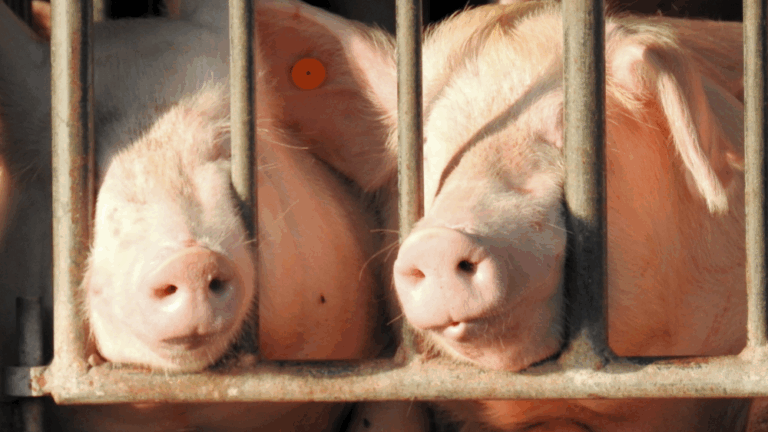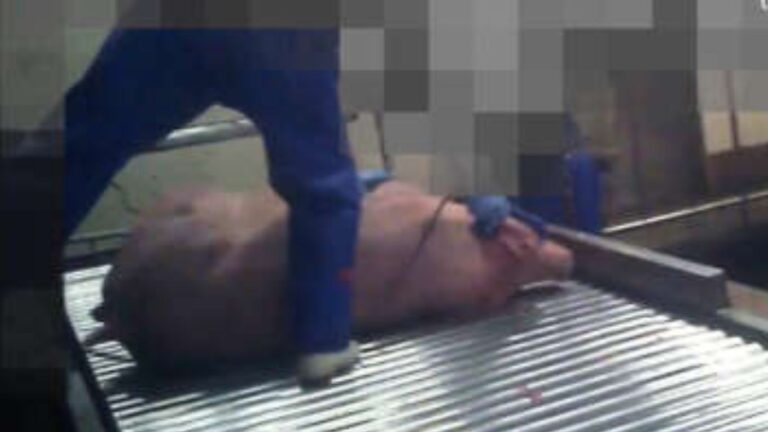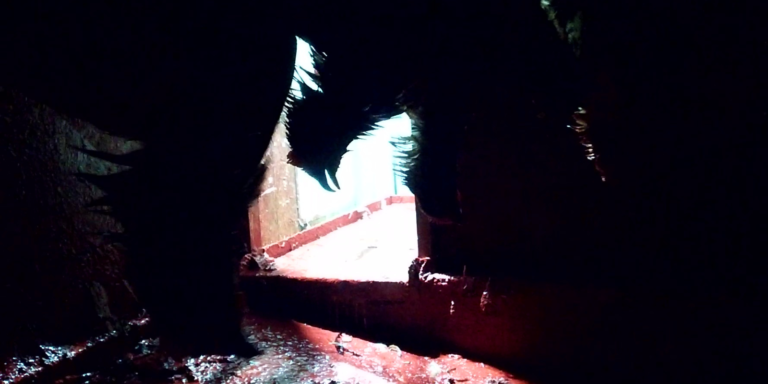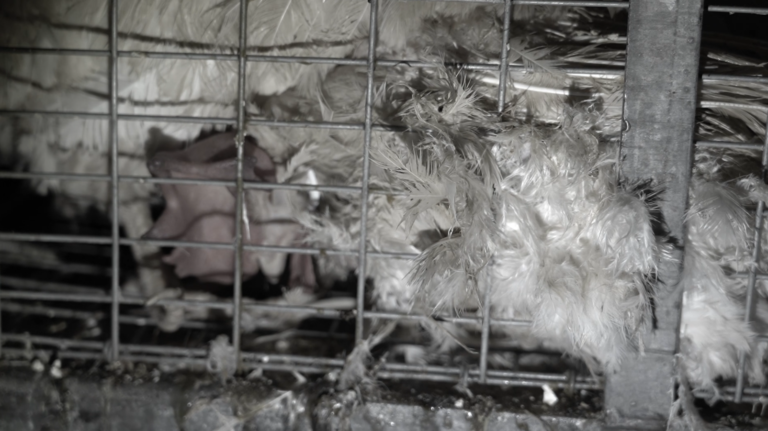Animals deserve water, even in their final days.
A 2023 survey conducted by the Animal Rights Center Japan revealed animals in Japan are denied drinking water at 38% of cattle, and 72% of pig slaughterhouses.
Pigs and cattle in Japan are transported for hours, often up to a day, before arriving at a slaughterhouse. There, they might endure an entire day before their slaughter takes place, and during all that time might not receive drinking water, even in Japan’s intense hot summers. According to a survey conducted from May to July 2023 by the nonprofit Animal Rights Center Japan, 37.82% of cattle, and 71.64% of pig slaughterhouses in Japan lack drinking water facilities for animals in waiting.
Background
The guidelines for slaughterhouse establishments and equipment issued by Japan’s Health and Welfare Ministry on June 23, 1996, states “drinking water facilities for livestock must be provided.” The animal health code for slaughterhouses established by the World Organization for Animal Health (OIE) in 2005 also states “Suitable drinking water should be available to the animals on their arrival and at all times to animals in lairages unless they are to be slaughtered without delay,” thus, installation of drinking water facilities for animals are essential. (*1)
A more recent article on 2013 entitled Installation of Drinking Water Facilities for Livestock at Slaughterhouses (Hokkaido Obihiro Meat Inspection Center, Hisashi Okuno et al.) (*5), reveals statistics on drinking water facilities at slaughterhouses in Japan between 2010-2011. It found that 50.4% of cattle slaughterhouses and 86.4% of pig slaughterhouses did not have drinking water facilities.
Seeing this situation, Animal Rights Center Japan launched a lobbying campaign to ensure drinking water facilities be installed. The Ministry of Health, Labour, and Welfare issued an improvement notice (*2) to prefectures in response to a questionnaire submitted in February 2017; however, the notice was loose, only requiring that drinking water facilities be installed when slaughterhouses are newly built or reconstructed.
On the other hand, 100% of the slaughterhouses licensed to export to Europe and the United States are equipped with drinking water facilities because EU and U.S. regulations require that “drinking water must be available at all times unless slaughtered immediately after unloading.” In other words, while animal welfare is ensured for cattle destined for export, cattle destined for domestic consumption are not given due consideration, resulting in an unbalanced situation.
Subsequently, Animal Rights Center Japan is negotiating with major meat companies to install drinking water facilities. As a result, in 2021, NH Foods Ltd. announced that all of its slaughterhouses will be equipped with drinking water facilities by 2023, and Starzen Co. similarly announced in 2022 that it had already installed drinking water in its slaughterhouses. These improvements prompted Animal Rights Center Japan to conduct a survey on slaughterhouses.
Survey results for 2023
The findings below include the responses from written and telephone surveys, as well as information from announcements made by major companies and from individual meetings with slaughterhouses.
Cattle slaughterhouses (119 in total)
62.18%, 74 establishments, had facilities with full-time access to water, up to 65.54% if the four establishments scheduled for installation are included. This indicates 12.58% of the establishments have made improvements in the 12 years since 2011.
| Water Facilities Available | Water Facilities to Be Installed | No Water Facilities | Unknown/No Response |
| 74 | 4 | 16 | 25 |
| 62.18% | 3.36% | 13.45% | 21.01% |
Pig slaughterhouses (134 in total)
28.36%, 38 establishments had facilities with full-time access to water, up to 36.57% if the 11 establishments scheduled for installation are included. This indicates 22.97% of the establishments have made improvements over the 12 years since 2011.
| Water Facilities Available | Water Facilities to Be Installed | No Water Facilities | Unknown/No Response |
| 38 | 11 | 45 | 40 |
| 28.36% | 8.21% | 33.58% | 29.85% |
There has been some improvement due to the growing domestic interest in animal welfare, the inclusion of animal welfare in ESG disclosures, and pressure from citizens and NGOs like ours. However, at the current rate of progress, it would take until the year 2049 for cattle and 2057 for pigs to have drinking water facilities installed in all slaughterhouses.
Pigs and chickens are more susceptible to water deficiency than other livestock animals. (*3) However, of the 63 establishments that handled both cattle and pigs, 23 had different handling practices based on animal species, and in all cases, only pigs were denied drinking water.
Slaughterhouses with Different Handling for Pigs and Cattle Among 63 Facilities Handling Both
| Water facilities for cattle but not pigs | No water facilities | Water facilities for cattle and pigs to be installed | Water facilities for cattle and pigs |
| 23 | 10 | 4 | 25 |
When they arrive at slaughterhouses, animals are showered to wash off urine and fecal matter, but this should not be regarded as the availability of drinking water. The OIE stipulates that “Drinking water should always be available to the animals, and the method of delivery should be appropriate to the type of animal held [in lairages – temporary holding pens],” and licking water mixed with feces and urine on the surface of the floor and drinking it poses a hygiene issue. Furthermore, the showers are only brief, so in any case wouldn’t satisfy the water needs of the animals. In addition, the time in lairages often exceeds eight hours, sometimes extending to a full day, thus showers cannot serve as drinking water facilities. Fresh water must be available at all times so that the animals can drink immediately when they feel the need.
Regarding these findings, Mr. Hisashi Okuno (currently the secretary-general of the Animal Welfare Livestock Association and a commissioned slaughterhouse inspector in Hokkaido), who conducted the 2011 survey, while commending the improvement, said: “This is an extremely disappointing outcome in terms of the installation of drinking water facilities. As a matter of course, the ability to drink water and stay hydrated is a right that no living creature should be deprived of. It must always be ensured. Ideally, we would like to discuss and examine the form, location, and number of [drinking water] facilities, and how to make them more accessible to livestock and more secure and sufficient for them to use. That’s how I hope things will be. Whether or not we have rules and regulations, it is a matter of care and ethics, something that we, as people who benefit from livestock products, must take responsibility for.”
What happens if there are no drinking water facilities?
Mr. Okuno began his investigation in 2010 when he noticed that cattle had died at a slaughterhouse where he had gone to conduct an inspection, and that water was not available.
The animals are transported on the decks of trucks and are rocked back and forth from side to side, which causes a great deal of strain on them. Needless to say, they cannot drink any water on the road. During summer, when temperatures in many parts of Japan go above 35 degrees Celsius, the animals are often brought in, foaming at the mouth, or gasping and struggling for breath. When they finally arrive at the slaughterhouse and are placed in the lairage, they are suffering extreme dehydration.
Pigs drink 100 ml of water per kg of body weight per day, which triples on hot days. Most of the pigs that come to the slaughterhouse weigh about 115 kg; therefore, 11.5 liters of water are needed per pig. One study found that pigs whose water was deprived for eight hours became so thirsty that 0.92% died the next day and 4.6% became ill even when water was provided. (*4) They have been observed shaking their head, foaming around the mouth, with an inability to stand or walk normally, or dropping into comas, and the inside of their ears turning blue, sometimes even partial necrosis of the brain upon autopsy. This is called acute water loss syndrome, also known as salt poisoning. In mild cases, thirst, constipation, skin irritation, and loss of appetite appear; in severe cases, typical symptoms include depression, cortical blindness (resulting in blindness), facial muscle and ear twitching, falling sideways, wandering, bumping into things, head tremors, dog-sitting posture, and flailing limbs.
In 29% of cattle slaughterhouses and 23% of pig slaughterhouses, the animals are sometimes kept in the lairage for 24 hours or more, the possibility of salt poisoning becomes greater when water is cut off for 24 hours. Making water available for drinking at all times is not only a matter of animal welfare considerations, but also a health issue. Moreover, a place where a large number of immune-compromised animals congregate could easily become a breeding ground for bacteria and viruses, which could be a food safety and human hygiene issue. Animal Rights Center Japan urges that all slaughterhouses be equipped with drinking water facilities as soon as possible so that the animals can drink water at all times. We hope that the desire to drink water, one of the five freedoms of animal welfare and the most basic need of all, will at least be fulfilled on the last day of the animals’ lives.
*1 https://www.hopeforanimals.org/slaughter/515/ (provisional translation)
*2 Installation of drinking water facilities for animals and livestock in slaughterhouses that are newly constructed or reconstructed (a notice issued by the Inspection and Safety Division, Department of Environmental Health and Food Safety, Pharmaceutical Safety and Environmental Health Bureau, the Ministry of Health, Labour and Welfare)
*3 https://www.jstage.jst.go.jp/article/jvma/68/7/68_429/_pdf/-char/ja
*4 https://vet.uga.edu/ivcvm/courses/afip/conf06/wsc20/c02.htm
*5 https://www.jstage.jst.go.jp/article/jvma/66/12/66_875/_article/-char/ja/











